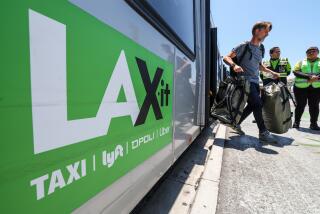Pains, trains and automobiles
- Share via
NEW YORK — Eric Gsellmeier’s shortest commute home this week began in downtown Manhattan at 4:30 p.m. and ended two hours and 20 minutes later in his three-bedroom Colonial home in Westwood, N.J., 27 miles to the north.
It included a rattling subway ride, a 30-minute wait in an unmoving line in the Port Authority Bus Terminal and a halting, hourlong bus ride in the dark, where commuters squeezed up and down the aisles, some standing with hands pressed against overhead compartments for stability.
And that was an easy day.
“The lines are insane; it’s disorganized — they just don’t have the capacity for all these people,” said Gsellmeier, 29, who works in information technology consulting.
Gsellmeier is one of the tens of thousands of workers whose normal commutes are still disrupted two weeks after Superstorm Sandy flooded tunnels, shorted out power stations and destroyed signaling equipment in New York and New Jersey, upending the mass transit system. While some subways are back in service, transit officials are working to restore some of the most popular and heavily trafficked train lines, but say it could still be weeks before travel is back to normal.
“We’ve been doing the best we can under difficult circumstances,” said Port Authority spokesman Ron Marsico.
PATH, the train system run by the Port Authority, used to carry 260,000 commuters on an average day, many of them through the World Trade Center and Hoboken hubs. But both hubs are out of service, and commuters are instead redirected to buses, overloading them.
The buses depart from the Port Authority terminal, which has seen lines stretching out the doors since Sandy. Officials have installed barricades and caution tape and enlisted dozens of police to keep lines orderly. Ask the frustrated commuters waiting in these lines what their longest commute is, and many will say two to three hours one way.
“This is miserable. I’ve never seen lines like this,” said Denise Duran, 38, who moved to New Jersey in October, only to see her 45-minute commute to Rutherford turned into a miserable hours-long trek.
New Jersey Transit, which carries 136,000 people into Manhattan on an average day, has reduced service too. Spokeswoman Nancy Snyder said the train system was coping with washouts, broken wire-supporting poles, damaged drawbridges and power outages. Two boats and a shipping container washed up on New Jersey Transit tracks during the storm.
Because Manhattan is an island, the routes into the borough are limited. New Jerseyite Brandon Fetch tried driving, but, stymied by traffic and tolls, he returned to the long bus lines. Commuters can take ferries to Hoboken, across the river in New Jersey, but the boats are equally crowded, and the cost, at $10 per round-trip, adds up quickly when added to train fare.
Some people may be able to work from home, but not Gsellmeier, who just began a new job two weeks ago and needs stability — he and his wife are expecting a baby in May.
Before the storm, Gsellmeier would leave his office at 5 p.m., walk for 10 minutes to the World Trade Center and take a PATH train to New Jersey. He would then switch to a New Jersey Transit train, which dropped him off a few blocks from his house. He liked being able to kick back, stretch his legs and sometimes sip a beer on the train, and then walk home.
On Thursday, however, he left his office, hustling past tourists snapping photos of the New York Stock Exchange and past the Broad Street subway stop, festooned with yellow caution tape and still closed after Sandy. After a 10-minute walk he got into the subway, where water dripped from the ceiling, and rattled to the Port Authority stop, a 30-minute ride. On the way out of the subway he picked up a slice of pizza, but didn’t stop to eat it, saying, “Every second I delay means more waiting in line.”
He walked through the crowds at the bus station, standing in a line that went down a hallway, up a staircase and into another hallway where commuters stood and sighed. When the bus arrived, Gsellmeier climbed on and handed the driver the ticket, only to be told he was on the wrong bus and should get off and try another one.
“I’m not waiting in another line,” he said, continuing to climb aboard. He pulled out his phone and texted his wife, asking her to pick him up at the bus’ last stop, 10 minutes from home.
Gsellmeier snagged a seat, though other unlucky commuters stood in the aisles, their arms bracing them as the bus stopped and started in traffic. He tried to read his Kindle, but the twists and turns made him feel carsick. Instead, he stared out the window, or at the gray fuzzy seat in front of him.
“I go from above-average stimulus during my work day to waiting in line and sitting on a dark bus,” he said. The grim faces of those around him seemed to echo the sentiment: For New Yorkers accustomed to bustling haste, the new commutes are achingly slow.
The bus crawled along, stopping every time a passenger requested, sometimes just blocks apart. Gsellmeier was the last to disembark, after 12 stops. He stepped out onto the cold New Jersey street, relieved to be close to home. Then he got a text from his wife, who was supposed to pick him up.
She was stuck in traffic. He would have to wait.
More to Read
Sign up for Essential California
The most important California stories and recommendations in your inbox every morning.
You may occasionally receive promotional content from the Los Angeles Times.











